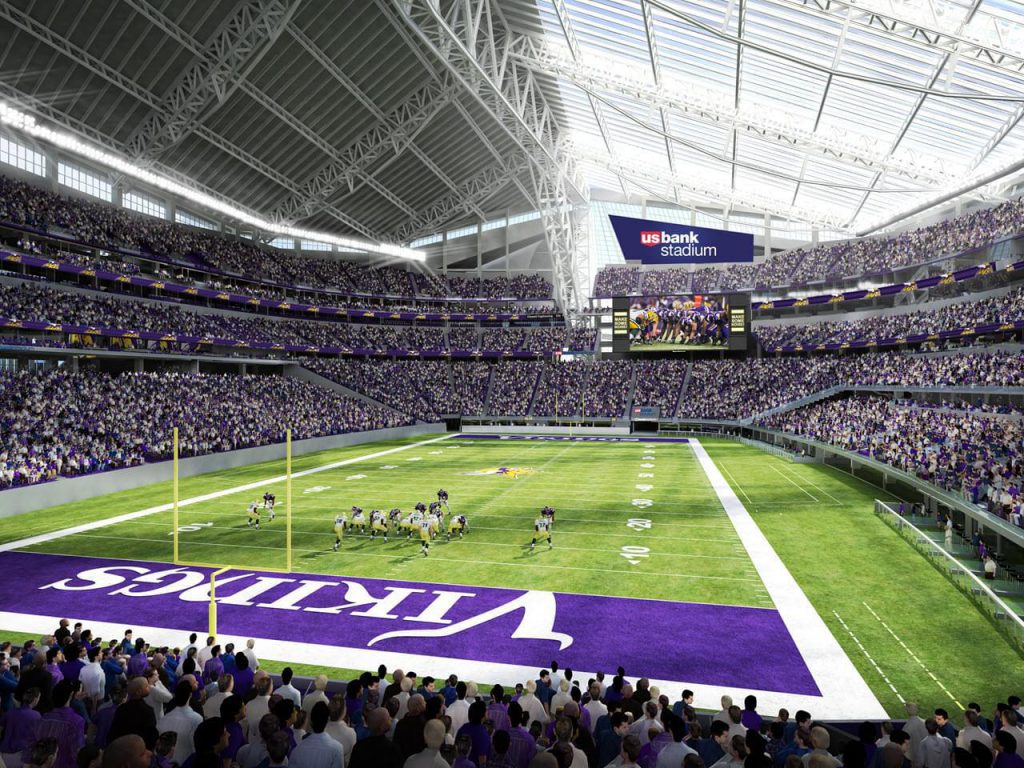
NFL team will play its first game at the new U.S. Bank Stadium on Sunday.
On Jan. 18, 2014, the air holding up the roof of the Hubert H. Humphrey Metrodome in Minneapolis, Minn. was deflated for the final time. Less than three years later, the National Football League’s (NFL) Minnesota Vikings will attempt to let the air out of their central division rival Green Bay Packers in the Vikings’ newly constructed U.S. Bank Stadium on NBC’s Sunday Night Football.
Viewers will immediately notice the missing air-supplied roof, a trademark of the old Metrodome. In its place will be an innovative fixed roof that is 60 percent transparent, allowing stadium attendees to view the sun and sky throughout the year while staying in a climate-controlled environment.
The new stadium’s centerpiece translucent roof was designed specifically to make it instantly recognizable to TV viewers. It also is expected to be loud, making it tougher for rival teams to get their plays off at the line of scrimmage.
But there’s something else worth mentioning about the new stadium: It was built with 14,400 tons of American-made steel.
A New Home
The numerous problems keeping the air-supported Metrodome roof aloft while facing the elements of cold, rain and snow had become a joke around the NFL. After years of discussions, a serious plan began to take shape in 2010 to replace it.
In December 2013, a groundbreaking ceremony took place for a new stadium to be built on the same site as the Metrodome. Serious demolition of the Metrodome did not get underway until early 2014.
But from the start, regional and local sourcing of workers and materials was a top priority. Of the nearly 250 trade partners involved in the project, more than 90 percent were Minnesota-based companies, while 37 percent of the workers were minorities. Additionally, almost 10 percent are women, surpassing the goal set by the state of a 6 percent woman workforce.
It also was a priority to source locally made steel, whenever possible.
The total steel budget for the stadium was $82 million including purchase, fabrication and erection. Of that, $77 million went directly to American-made steel.
Two Minnesota companies oversaw much of the project. LeJeune Steel Company of Minneapolis did the fabrication, and Danny’s Construction Company of Shakopee completed the erection of the steel with the help of Ironworkers Local 512.
But finding the right steel for the stadium’s trademark roof was a challenge. The ethylene-tetraflouroethylene (ETFE) roof, the largest in America, gives fans an outdoor feel even though Minnesota could be going through the depths of another bone-chilling winter. Supporting the unique ETFE roof is a main truss of grade 65 steel manufactured by ArcelorMittal in Luxembourg.
“There are no manufacturing plants in the United States that make grade 65 steel,” said Michele Kelm-Helgen, chairperson of the Minnesota Sports Facilities Authority. “Grade 65 steel was used for the main truss that is used for an extremely long span of the roof. The long span steel was required to be of a certain length and strength that is only manufactured in Europe.”
But as Kelm-Helgen points out, “ArcelorMittal owns and operates facilities on the Iron Range in Minnesota – the ArcelorMittal Minorca Mines and the Hibbing Taconite Mines.”
ArcelorMittal, the largest producer of steel in the world, also is heavily invested in its American Operations, supporting 20,000 American workers at 27 U.S. operations. In addition, the company is supportive of Buy America preferences for domestic steel.
The purchase of the grade 65 steel equaled $5 million, which is 6 percent of the total budget.
“The remaining $77 million was spent with domestic companies procuring additional steel for other parts of the building,” said Kem-Helgen. “There were 14,400 tons of grade 50 steel that was manufactured and purchased in the United States.”
The rebuilt U.S. Bank Stadium was officially completed in July, and Sunday’s “black and blue division” matchup between the Vikings and Packers will unveil the state-of-the-art facility to football fans across the globe for the first time.
The stadium covers approximately 1.75 million square feet and has a seating capacity of 65,400 seats, which is expandable to 72,000 for a Super Bowl Game, like the championship it will host in 2018.
There are seven levels with up to 116 suites and 8,000 club seats, including suites and clubs at the field level. There will be access points to the city and stadium site from all four sides of the stadium.
The stadium project is the largest public works project in state history. It is the centerpiece of a major redevelopment in the Downtown East area. The East area will now be available for year-round use for the citizens of the Twin Cities.
So revitalization of a city comes along with expense of the venue itself. Of the projects $1.09 billion upfront capital costs, $577 million or 53 percent of the stadium cost, will be paid by private funds.
The stadium’s unique design is suitable for a number of sporting and concert events.
In the past, it has seemed Minnesotans have operated efficiently, but under-the-radar, never wanting to cause a commotion and bring undue attention to the Gopher State.
If the U.S. Bank Stadium catches on with a national fervor, the old-time, laid-back Minnesota natives might just have to sit back and listen to one of their own Hibbing-born talents, Bob Dylan: “The Times They Are A Changin’.”
